Thanking our Visiting Guest Critics and Reviewers — 2021-2022
May 20, 2022
The Azrieli School of Architecture & Urbanism thanks everyone from outside the school who participated in student projects during the 2021-2022 academic year.
Architects, architectural practices, teachers from other institutions, and community members contributed insights, expertise, and observations to enrich the learning experience.
We are grateful for their thoughtfulness and generosity with time that participating in reviews requires.
The school also thanks the numerous organizations and their representatives who provided information about project sites and social needs, as well as bringing the client voice to reviews.
Below is an outline of the studios which have benefitted, and a list of many of the people who helped make this lively dialogue possible.
If we have inadvertently missed your name, please contact mariacook3@cunet.carleton.ca
ARCN 5302/ARCS 6002 Daedelic Exercises II (un)Rapid Prototopying
Associate Professor Lisa Moffitt
GUEST CRITICS:
Omer Arbel — Principal Omer Arbel Office and Bocci
Dr. Miguel Paredes Malconado — Lecturer in architectural design, University of Edinburgh
Leslie Lok and Sasa Zivkovik, Founders of HANNAH
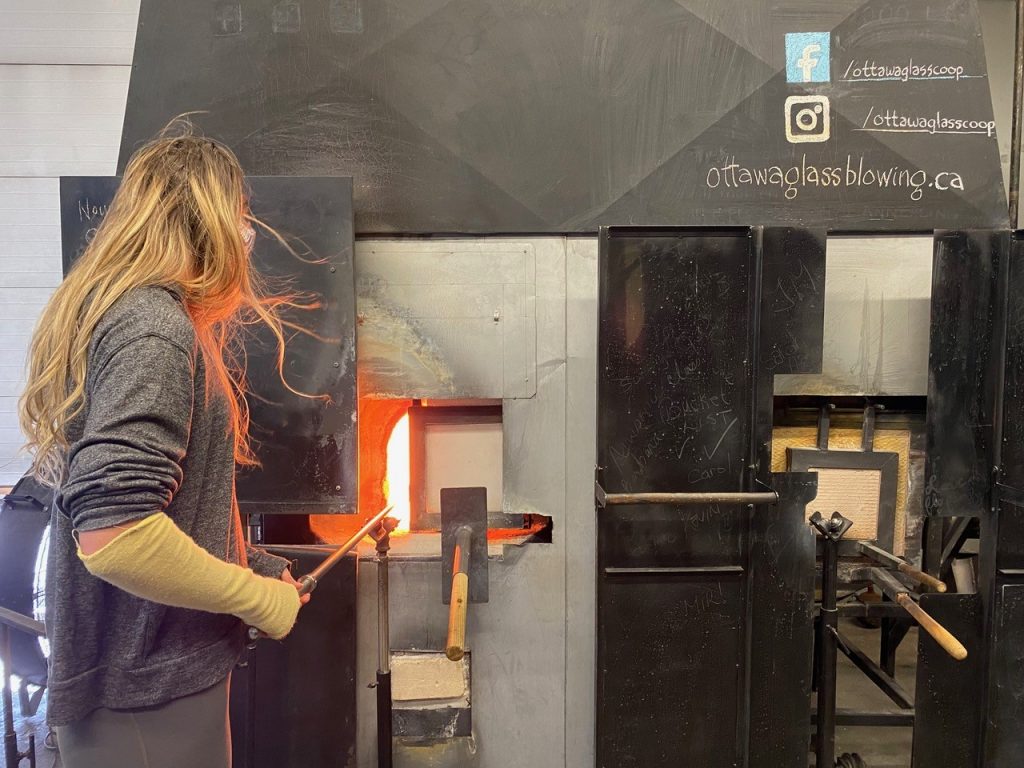
Alexandra Telford completes an introductory glassblowing class at Ottawa Glassblowing Coop for Professor Lisa Moffitt’s PhD and MArch (un)Rapid Prototyping course.
Course Description: This course explored analog and digital prototyping — loosely understood as the 1:1 construction of a physical artefact for design speculation — from three vantage points. 1. Students explored the prototype as a mode of design research as it relates to discourse in architectural theory. 2. They looked at precedent practices that rely on prototyping as a way of understanding a range of methods and artefacts of the prototopying process. 3. They constructed physical prototypes digitally, by hand, or using hybrid techniques to further specific PhD or MArch thesis design and research interests. The course is structured around themes of craft, computation, and authorship to frame ways of making, writing about, and presenting physical artefacts.
ARCS 5105 Gateway Studio: Urban Forestry Workshop
Associate Professor Lisa Moffitt, Associate Professor Paul Kariouk, Assistant Professor Jerry Hacker and Instructor Adrian Dyer
GUEST CRITICS:
Carol Burns — Associate Professor of Architecture, Wentworth Institute of Technology, Principal, Taylor & Burns Architects
Natalie Petricca — Associate Architect, Stantec
Chris Pommer — Principal, PLANT Architect
Rebel Roberts — Vice President and Discipline Leader of Architecture, Stantec
Jelisa Blumberg — Adjunct Assistant Professor, Columbia University, core member, Dark Matter University
Brenda Webster Tweel — Senior Associate of Urban Spaces, Stantec
Curry Hackett — Principal, Wayside Studio, core member, Dark Matter University
Elisa Costa — Associate Architect, Stantec
Aliza Sovani — Co-founder, Head of International Relations, lili media and design
James Strong — Intern Architect, Stantec
Aleksandra Jaeschke — Assistant Professor of Architecture and Sustainable Design, University of Texas at Austin
Lisa Rapoport — Principal, PLANT Architect
Anya Sirota — Associate Professor, Associate Dean for Academic Initiatives, Taubman College of Architecture and Urban Planning, Founding Principal, Akoaki

Kaleigh Jeffrey’s urban forestry workshop sectional perspective completed in Professor’s Paul Kariouk’s Gateway Studio section.
Studio Description: Rigorous siting and detailed design of an urban forestry workshop acts as a lens for understanding some of the complex histories and entanglements between Canada’s natural and cultural histories of forestry and wood production in light of the climate crisis. The project site is a narrow section of land located between the highly urbanized edge of Hull’s Portage office complex and a National Capital Commission path that is a part of Ottawa’s ceremonial route. Students developed a large-scale landscape strategy managing mature and sapling tree cultivation on the extended site. They then designed a 40,000 square-foot public facility containing greenhouses, laboratories, workshops, meeting and exhibition spaces to a high degree of technical resolution with regards to materiality, structural and environmental performance.
ARCS 5031 MArch 1 Studio 1: Architecture in the Time of COVID
Associate Professor Zachary Colbert and Assistant Professor Suzanne Harris-Brandts
GUEST CRITICS:
Thena Tak — Lecturer, University of British Columbia School of Architecture and Landscape Architecture
Christopher Romano — Assistant Professor, University at Buffalo School of Architecture and Planning
Andrew Lucia — Co-founder LUCITO.
Vedanta Balbahadur — Instructor, McGill University, founder of Studio Vedanta Balbahadur

Drawing by Arkoun Merchant
Studio Description: Initiated in response to the COVID-19 pandemic, this studio used design-research to establish novel architectural approaches that integrate public health, economic recovery, and social inclusivity. We now live in an age of global pandemics. As the human population continues to grow and expand into natural areas, pandemics will occur with greater frequency. Our discipline must envision just solutions that tap into the productive intersections of public health, social justice, and the built environment, establishing new design standards and regulations. Much like the accessibility turning radius introduced as a part of universal accessibility and barrier-free standards, the two-meter social distancing circle may now inform architectural design decisions and demarcate the public realm.
ARCS 5032 MArch 1 Studio 2: Montreal’s Urbanism and the Factory of the Future
Associate Professor Zachary Colbert and Assistant Professor Natalia Escobar-Castrillón
GUEST CRITICS:
Shannon Bassett — Assistant Professor, Laurentian University McEwen School of Architecture
Erkin Ozay — Assistant Professor, Director of Undergraduate studies, University at Buffalo School of Architecture and Planning

Drawing by Arkoun Merchant
Studio Description: Urban and architectural innovations to integrate industry back into the city in new ways is a highly complex socio-political project. For better or worse, architectural narratives tend to focus on the stuff of industry such as logistical systems, cybernetics, economies of scale, and assembly processes, where pragmatic considerations like cost and function are paramount. Yet, the ‘factories’ of production in urbanism are as much factories of ideas as they are factories of products or goods. In this course, students prototyped and explored the politics of the meta-industrial city through architectural working drawings that documented both the mundane moments of daily life and the fantastic possibilities of a highly speculative architecture.
ARCS 4304 – Urbanism Studio 5: Global Perspectives Winter 2022
Endangered Landscapes: the Indigenous settlements in the Araucania, Chile
Instructor Gonzalo Munoz-Vera
GUEST CRITICS:
Prof. Clara Irazabal –— Director of the Urban Studies and Planning Program, School of Architecture, Planning and Preservation, University of Maryland
Nik Luka — Associate Professor cross-appointed to McGill University’s schools of architecture and urban planning
Madelaine Snelgrove — Master of Landscape Architecture student, University of British Columbia
Studio Description: The studio took the17th Venice Biennale’s theme “How we will live together?” as its premise, focusing on a study of the Araucania Region, Chile. The largest Indigenous community in the country (Mapuche) resides in this southern territory, which has historically dealt with land and culture conflicts from settler and mixed-race oppressors, including forestry companies that threaten indigenous settlements and their environment. An immersive remote study of this conflict and analysis of the territorial information and historical documents provided the basis for design strategies at different scales. Students were invited to learn about a culture and landscape often ignored or unknown to create innovative and unbiased content.
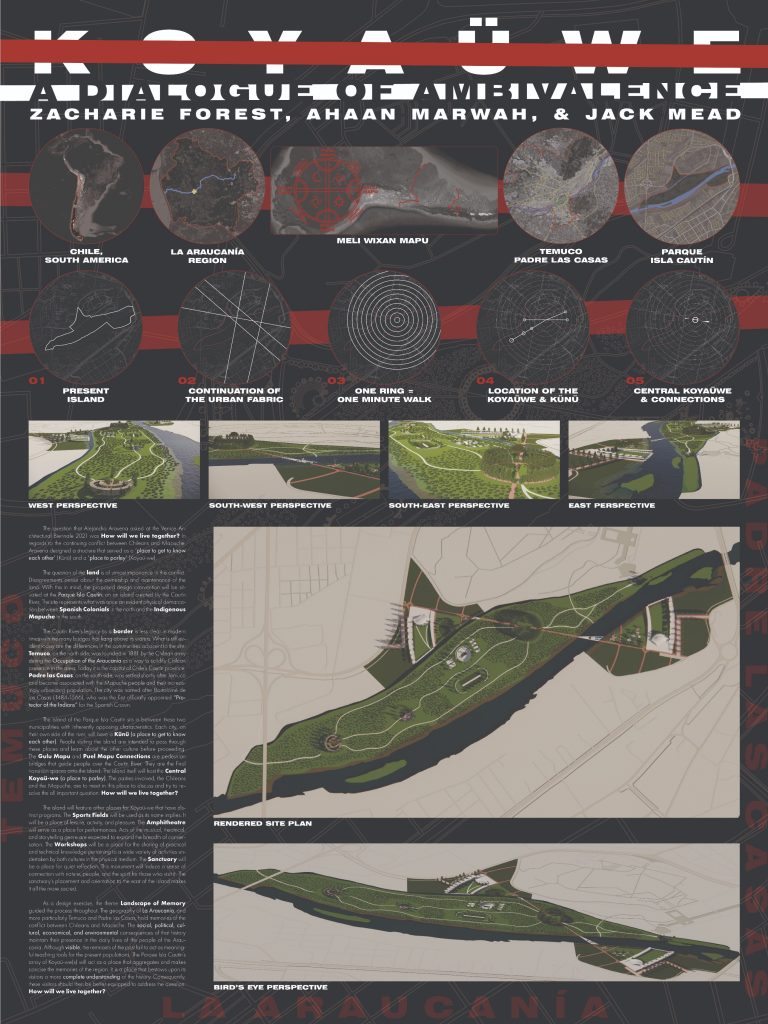
Drawing by Zacharie Forest, Ahaan Marwah and Jack Mead
ARCS 4107A Studio 7 Formation
Associate Professor Johan Voordouw
GUEST CRITICS:
Dong-Sei Kim — Assistant Professor in Architecture, New York Institute of Technology
Linda Zhang — Assistant Professor, School of interior Design, Toronto Metropolitan University
Andrew Lucia — Co-founder LUCITO
Studio Description: Formation explores architecture as open-ended, emergent, variable, ephemeral and pervasive. Formation can be thought of in several different but related ways. It can either be something in the process of becoming, something that already is, or an order or arrangement. This gets to the heart of the studio and its desired raison d’etre. In this studio, architecture is not fixed. There will likely be no finished building, only a series of more refined and ] elaborate spatial studies. In formation, buildings are situated within a broader system of social, political, and environmental forces. Architecture is an agent that pushes and pulls on these systems and is shaped by them in turn.

Drawing by Will Hermer and Rafael White
ARCS 4107B Studio 7 Tank Words: Port Hope
Associate Professor Lisa Moffitt
GUEST CRITICS:
Karen Lutsky — Assistant Professor in Landscape Architecture, University of Minnesota
Sean Burkholder — Assistant Professor in Landscape Architecture, University of Pennsylvania
Elise Shelley — Assistant Professor in Landscape Achitecture, University of Toronto
Jessica Rossi-Mastracci — Assistant Professor in Landscape Architecture, University of Minnesota
Sandra Weeks — Port Hope Area Initiative communications officer
Faye More — Port Hope Community Health Concerns Committee

Dan Vu and Tobia Graziani’s sediment filtration model studies completed in Professor Lisa Moffitt’s Tank Worlds: Port Hope fourth year studio
Studio Description: Port Hope is home to one of the oldest and largest uranium conversion facilities in Canada. Between 1933 to 1953, waste from the refining process was distributed throughout the town, leading to large-scale soil and sediment contamination. In 1987, Port Hope Harbour was designated as one of Canada’s nine Great Lakes Areas of Concern. The federal government commissioned the Port Hope Area Initiative, an extensive remediation of sites throughout Port Hope and the harbour. Remediation is underway, but how the public will occupy remediated sites in the future is unclear. Using tank-world models, mappings reliant on GIS and satellite imagery, and video, students designed possible post-remediation futures for a portion of Port Hope Harbour and surrounding areas.
ARCS 4107D Studio 7 Sacred Space | Sacred Place
Contract Instructor Isabel Potworowski
GUEST CRITICS:
Dr. Michael Crosbie — Professor of Architecture, University of Hartford
Cecilia Dobos — Founder of Studio CLAUD and Budapest Urban Ideals
Rehab Salama — Intern architect, Moriyama & Teshima Architects
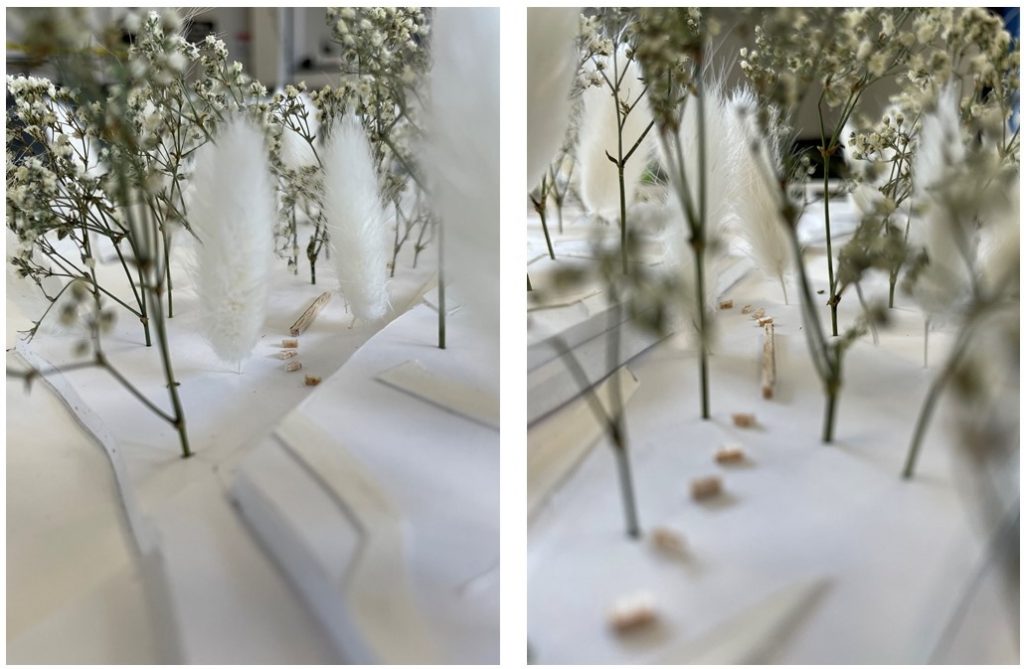
Work by Elizabeth King
Studio Description: How can we design sacred spaces today? Traditionally, sacred space has been conceptualized in opposition to profane space. It has also referred primarily to buildings with a religious function. However, there is a growing recognition that all of reality is potentially sacred. As well, certain secular buildings can express sacred qualities. In certain such places, just as in temples and chapels, one can experience wonder, awe, silence, transcendence, nostalgia, and desire in front of something which seems close to us, even a part of us, yet which remains beyond, ungraspable, ineffable. This studio explored the connection between place and the sacred through the design of a sanctuary.
ARCS 4105/4301 Bachelor of Architectural Studies Comprehensive Studio
Associate Professor Benjamin Gianni, Assistant Professor Piper Bernbaum, Adjunct Professor John Cook, Adjunct Professor Honorata Pienkowska, Instructor Jelle de Roek and Instructor Nicole Moyo.
GUEST CRITICS:
Gordon Lorimer — Partner, Special Projects, Hobin Architecture
Roderick Lahey — Principal, Roderick Lahey Architects
Robin Souchen — Manager Realty Services, City of Ottawa
Edith Tam — Planner, City of Ottawa
Robert MacNeil — Director Realty Initiatives, Ottawa Community Housing
Samantha Schneider — Project Lead, Simmonds Architecture
Kevin Harper — Development Manager, the Minto Group
David Renfroe — President, Renfroe Land Management
Pascale Lépine — Community and Land Development Coordinator, Lépine Apartments
Eric Haar — Project Management and Marketing, Architecture49
Renee Reder — Architect, KWC Architects
Gail Shillingford — Principal, Planning and Landscape, B+H Architects
Kevin Desjardins — intern Architect, Brigil
Ryan Koolwine — Principal, Project1 Studio
Alex Leung — Principal, grc architects
Jennifer Esposito — Associate Architect, superkül
Scott Hayward — Simmonds Architecture
Martin Tite — Principal, grc architects
Marc Thivierge — Architect, Director, Hobin Architecture
Andrew Butler — Practice Leader, HOK
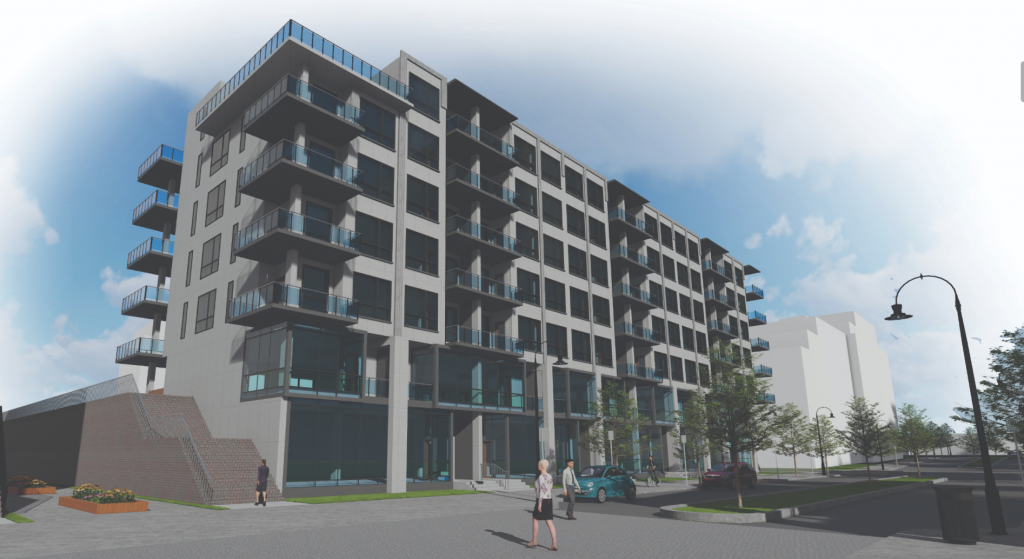
Drawing by Jack Mead
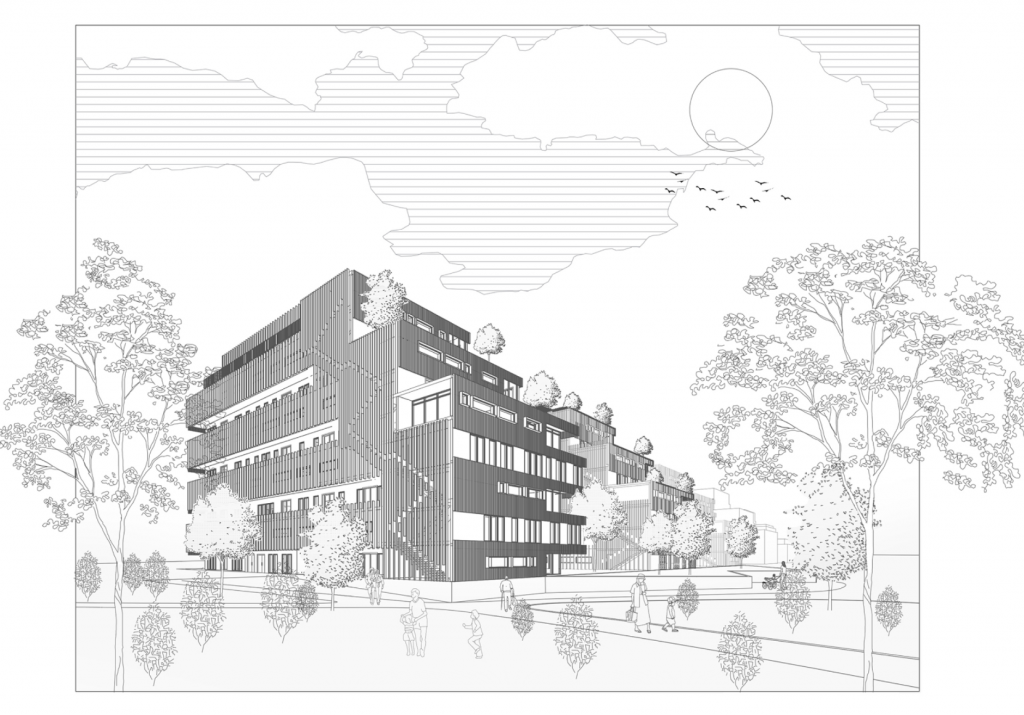
Drawing by Sideqa Hasani

Drawing by Tobia Graziani
Studio Description: The penultimate studio in the Bachelor of Architectural Studies program is a comprehensive studio that engages the issues of design in a detailed and inclusive manner. Projects are expected to reach a high degree of formal and tectonic resolution using sophisticated modes of representation. Students are expected to carefully study the structural systems and envelope designs of their buildings and explore basic mechanical and electrical systems as an integral part of the design process. They must consider the social, economic, and environmental implications of the choices they make. This studio addresses selected architectural questions through the detailed integration of site analysis, program development, master planning, concept development, placemaking, building components and systems, structure, materiality, and logic of construction.
ARCS 2303 Fundamentals of Urbanism
Associate Professor Benjamin Gianni
GUEST CRITICS:
Amy Falkner, Retired Planner, City of Ottawa
Randolph Wang, Planner, City of Ottawa
Studio Description:
The introductory studio course for urbanism majors explores basic approaches to the design of cities, moving up in scale and complexity from the design of individual buildings to collections of buildings at the scale of the street, block and neighbourhood. The course introduces terminology, tools, techniques, and conventions associated with the analysis and design of the built environment, as well as measures (regulations, policies, bylaws, etc.) used to direct the form, location and density of urban development. Studio work is supported by readings and discussions that situate urbanism in relation to architecture, urban design, planning, and other disciplines. Readings and discussions also address multiple and changing paradigms in urban design and city planning.

Drawing by Maya McManus
ARCS 2106 Building on Community
Associate Professor Janine Debanné, Adjunct Professor Eric Archambault, Adjunct Professor John Cook, Instructor Santiago Guardia
GUEST CRITICS
Heather Cameron — Managing Principal, CBStudio Architecture
Kenneth Hayes — Architectural Historian, Sudbury
Dr. Stephan Kowal — Montreal
Mathieu Fleury — Councillor, Ward 12, Rideau-Vanier
Louise Lalande — Partner, Lalande + Doyle Architects
Philippe Doyle — President, Lalande + Doyle Architects
Kareem Mitchell — Junior Architect, Hobin Architecture
Thi Phuong-Trâm Nguyen — PhD Candidate, Montreal
Studio Description:
The students received a “real world” project from Councillor Mathieu Fleury’s office at the City of Ottawa. The city wanted ideas for additions that included regulation-sized gyms and pools in older community centres (CC) in the Rideau-Vanier ward. They were the Richelieu Vanier CC, Champagne Baths, and the Sandy Hill CC. The project title, Building on Community, captured the themes of addition and of community life. Continuing the term’s theme of structural imagination and gathering, the students engaged in architectural conversations with an existing building.They focused on site plan, journey, tectonic dialogue with existing architecture, the meaning of community, and large span structures. The propositions breathed life into the humble action of adding “large boxes” to existing buildings.

Students conducting a site visit.
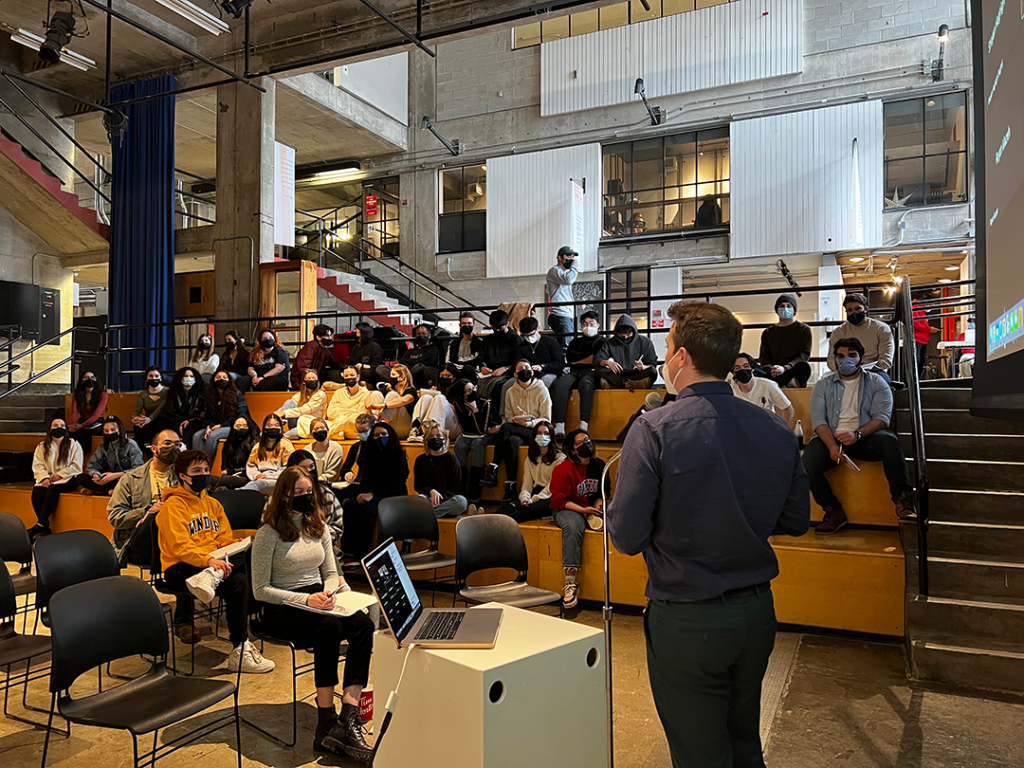
Councillor Mathieu Fleury speaking in the PIT of Building 22
Master’s Thesis Reviews
The Azrieli School of Architecture & Urbanism would like to thank the external examiners who joined us for Master of Architecture thesis reviews.
Vedanta Balbahadur — McGill University, Studio Vedanta Balbahadur
David Correa — University of Waterloo School of Architecture
Annalisa Meyboom — University of British Columbia School of Architecture and Landscape Architecture
Tom Bessai — Denegri Bessai Studio Architecture
Tom Carruthers — Dream the Combine and Cornell University
Jennifer Newsom — Dream the Combine and Cornell University
Vincent Debritto — University of Minnesota, Department of Landscape Architecture
Kai Wood Mah— Laurentian University, McEwan School of Architecture
Terri Fuglem — University of Manitoba, School of Architecture
Gordon Lorimer — Hobin Architects
Aliki Economides — Laurentian University, McEwan School of Architecture
Cyrus Peñarroyo — University of Michigan, Taubman College of Architecture and Urban Planning
Erin Putalik — University of Virginia Architecture School
Ivonne Santoyo-Orozco — Bard College
Christopher Romano — University at Buffalo, School of Architecture and Planning
Mitchell Hall — KPMB Architects
Kenneth Hayes — Architectural Historian, Sudbury
Titania Truesdale, Strutt Foundation
Karen Lutsky — University of Minnesota
Carleton University Guest Critics
We wish to acknowledge and thank the faculty, contract instructors and adjunct professors of the Azrieli School of Architecture who take part in studios and thesis reviews as guest critics.
We also thank the following graduate students who served as guest critics.
Reem Awad, PhD student
Damiano Aiello, PhD student
Rana Abughannam, PhD candidate
Émélie Desrocher-Turgeon, PhD candidate
Stephanie Murray, MAS student
Kristin Washco, PhD candidate
Simone Fallica, PhD student